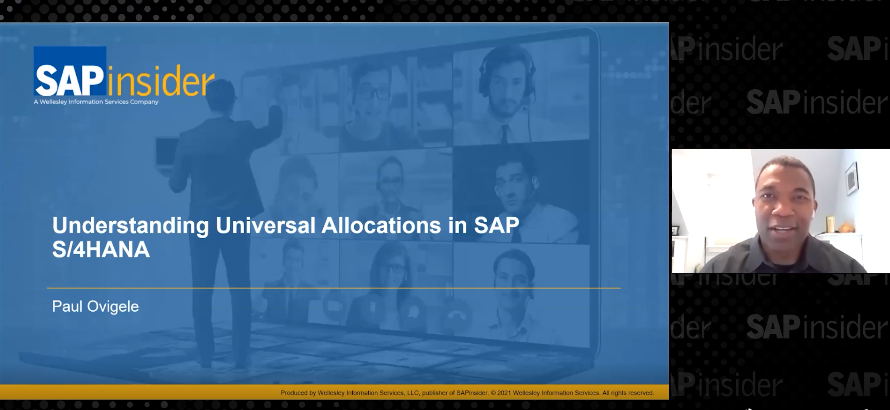Live from SAPinsider Studio: Rohana Gunawardena on SAP CO
Rohana Gunawardena, Director, SAP Practice, QS&S, joins SAPinsider Studio at the SAPinsider FIN 2016 event in Las Vegas to discuss the SAP CO philosophy and using CO beyond cost center accounting, such as internal orders, as well as what SAP S/4HANA means for SAP CO.
This is an edited version of the transcript:
Ken Murphy, SAPinsider: Hi, this is Ken Murphy with SAPinsider. I’m at the SAPinsider Financials 2016 event in Las Vegas. This morning I’m pleased to be joined by Rohana Gunawardena, who is the Director of the SAP practice for QS&S. Rohana is also a long-time speaker at the SAPinsider Financials event. Rohana, thank you for joining us today.
Rohana Gunawardena, QS&S: Ken, thank you very much for inviting me here. And thanks for the great intro, it’s a real pleasure to be here with you.
Ken: You are here today to talk to us a little bit about controlling issues in SAP, which dovetails with one of your sessions here. I was hoping to start if you can address one of the things you’re talking about in your session which is organizations that are using or relying on some of the more simple controlling options in SAP. Can you address the reasons for that? Is that maybe reluctance to use other modules because of some confusion over what the other modules deliver?
Rohana: That’s what’s driven my CO-based sessions here at the conference. I’ve got three sessions related to CO; right from the beginning what I find especially in the United States is people don’t understand the German GKP accounting philosophy that’s behind the management account and controlling philosophy that SAP has. So for the German accountant, CO makes perfect sense but for somebody who’s trained in accounting the U.S., UK, Australia, it seems rather confusing because of different outlook in the way the modules are built. One of the fundamental differences is in the German method people look at financial accounting and management accounting, or controlling, as two separate things. They might start from the same data, but have different objectives and different results. They don’t need to reconcile. And a classic problem that happens, every customer is using CO-PA and they say “Well, I’m trying to reconcile CO-PA to FI and I can’t make it happen.” And SAP’s intention from the beginning was that they don’t need to reconcile. And because of that difference people get confused and then they’re a little afraid of CO. And when I’m at my customers I do see that the part of CO that’s used the most is cost center accounting, and the cost center accounting is the bit of CO that makes the most sense for somebody who is used to U.S.-style accounting and so people use what’s most familiar to them, but more complex processes say things which involved a lot of settlements or things like CO-PA seem a bit more confusing and people will avoid.
Ken: So what are a few effective ways to use that more advanced CO functionality?
Rohana: There are a lot of different things people can do. One, is OK, you’ve started cost center accounting what’s the next simplest thing you can use to slowly get yourself into the process? An area I’d recommend people is using internal orders; the internal order concept is very different to what people are used to in general accounting in the U.S. they would look at management accounting. But it’s a way of getting budgeting and cost reporting and revenue reporting at a below cost center level. And that is a useful management tool for matching costs and monitoring costs at a lower level than cost center. The second thing I’d recommend people is getting ahold of the SAP IDES systems which is the Internet Development Education System; it’s free to all customers that are up-to-date with their license fees, and that’s the SAP system that’s already populated with configuration, transactional data so people can see examples of different transactions and can try things out without having to configure from the ground up. If people aren’t used to CO-PA already, then maybe look at CO-PA because that gives them great reporting functionality but that’s definitely more complex than starting with internal orders.
Ken: And for the company that’s considering a move to SAP S/4HANA Finance, how does that impact their CO data structure?
Rohana: There’s a short answer and a long answer. You mention the data structures; the short answer is no difference. If you have some Z program written today using some existing tables like COEP, COBK those will still exist , those reports will run if you’re used to analyzing raw data using tools like SE16 you’ll still be able to do that. The long answer is at the database level there’s a huge amount of change; but SAP has tried to make this as transparent as possible to the end users so what they’ve done is all of the existing tables, or the legacy tables are available as views. So they generate them as views so there’s now one table which has all of their FI and CO data at a line item level and all the current legacy tables generate these views of that new table. So it’s pretty transparent, it makes the transition very simple.
Ken: And does the S/4HANA and Universal Journal data models change the dependencies and integration between CO and FI?
Rohana: Like the previous question, simple answer is no but in a more detailed answer it’s going to – the dependences are going to link the modules together more closely, it’s going to make reconciliation between the modules much, much simpler than before. How I talk about this in my sessions when people have asked this is to look at a transition that SAP has made over time. It originally started with just classic GL, then classic GL progressed to New GL, SAP GL as it’s now known. And SAP GL took classic GL, profit center accounting, and reconciliation ledger and combined them together. Previously reconciliation ledger was a tool that was used to spot CO intercompany transactions and show that balances moved from one company to another within CO and made the appropriate corrections in the FI module. So SAP has those tightly integrated. Now, with Simple Finance it hasn’t so much merged them all into one tool, but it’s merged tables and underlying data structure together to simplify reconciliation, now you only have one true document within the SAP system at the database level and it makes reconciliation much, much simpler between the modules.
Ken: So that’s what SAP refers to as the single source of truth in Finance? But does running various or different CO modules run counter to that notion?
Rohana: No, because the data structures that SAP has provided for the single source of truth apply to all the CO modules. So whether you’re using internal orders, cost center accounting, the projects module, you’re using CO-PA they all flow into this one single line item transaction table and that means if people want to reconcile CO-PA to FI or material ledger transactions to FI transactions it’s going to be much simpler than it was before because there’s a 1-to-1 line item relationship.
Ken: Rohana, I know you’re very busy here at this event with all your sessions so I appreciate your taking time out to join us and to share your expertise.
Rohana: Well thank you very much for inviting me here Ken. It’s been a pleasure and it’s been great talking to you and our viewers. I hope they enjoy the session.





